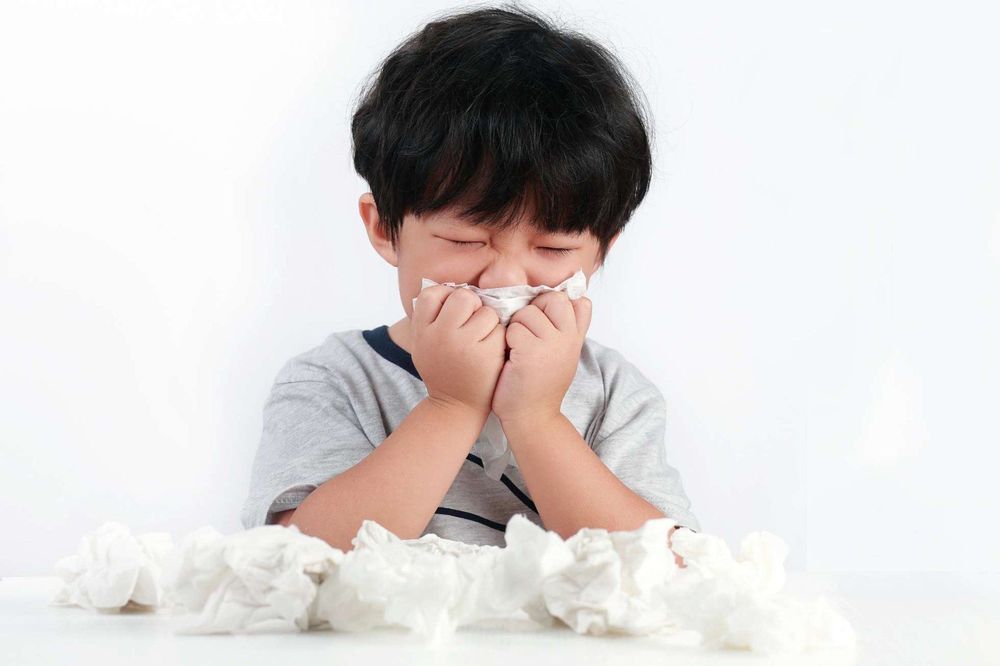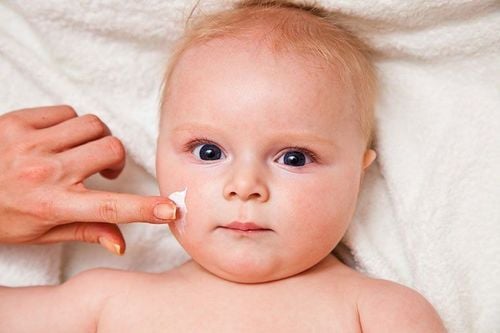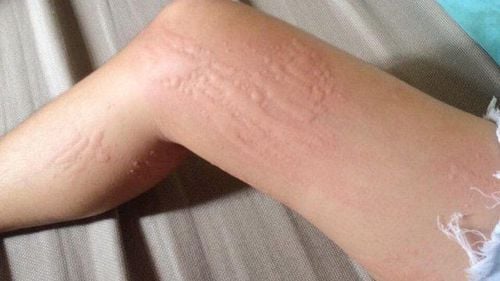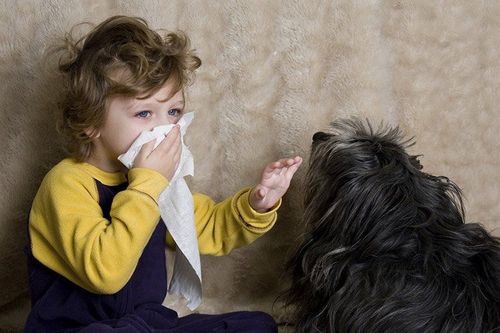This is an automatically translated article.
Allergies are always a common problem in young children. One of the main allergens is from household pets. Although, children by nature may not be allergic to pet dander, but they may come from pollen, dust and fungi on animal fur. How can I detect and prevent allergies due to this cause?1. What are pet allergies?
Pet allergies occur when a person develops an immune response to animal dander (skin dander), saliva, urine, or feces. Hair or animal dander itself is not an allergen, but it can be contaminated with pollen, dust, and mold, all of which can be allergens.When a child has a pet allergy from inhaling dirt or coming into contact with the saliva or feces of an animal, the child's immune system sets off alarms and releases histamine and more than 40 other chemicals designed to fight the allergen, causing symptoms such as sneezing and watery eyes.
Any animal with fur - including dogs, hamsters, guinea pigs, birds and especially cats - can cause a reaction in an allergic child. Even hairless or short-haired cats and dogs can cause allergies. However, some children with pet allergies are more likely to be allergic to certain breeds or even to individual animals.
2. Pet allergy symptoms in infants and children
Common signs and symptoms of pet allergies include:Runny nose Itching, watery eyes Sneezing Symptoms such as coughing or wheezing Skin Itching Raised, red patches on the skin (hives)

Sổ mũi, hắt hơi là hai trong số những triệu chứng phổ biến của dị ứng vật nuôi
3. When do pet allergies appear in infants and children?
Pet allergies can develop at almost any age, but they usually don't cause symptoms before 2 years of age.Common causes of stuffy noses and sneezing in babies are actually lint particles from new clothes and bedding. Using saline water for nasal drops, vacuuming, and washing all of your child's new items can help keep them away from these allergens.
4. What is the possibility of a child being allergic to a child or cat?
Anyone can have a pet allergy. However, your child is more at risk for pet allergies if:There is a family history of allergies or asthma. Have other allergies or allergy-related conditions such as asthma or eczema.
5. How do I know if my child is allergic to pets?
Your child may be allergic to a family pet if:The child's allergy symptoms appear year-round, as opposed to seasonal. (Though this could also be a sign of an allergy to dust mites, cockroaches, or mold.) Your child's symptoms improve after he or she is away from home – or your pet is out of the house for a long time (such as a family vacation). Your child's symptoms get worse when he or she plays or cuddles with family pets. It can be difficult to know if your pet is the cause of your child's allergies. Not keeping a dog or cat in the house during the test won't tell you much, as there will probably be enough pet hair in the house to cause allergies in your child even if your pet isn't around.
Even after leaving the house without your pet, your child may still have a reaction to chronic exposure and symptoms - once triggered - can occur for days after removal remove allergens, says allergist James L. Sublett, former president of the American Association of Allergy, Asthma and Immunology (ACAAI). Allergens will likely be transported to new environments on clothing and other items, he said.
You may have to take your child to an allergist to find out if your pet is causing allergy symptoms.

Bạn có thể phải đưa con mình đến bác sĩ chuyên khoa dị ứng để tìm hiểu xem liệu thú cưng của bạn có gây ra các triệu chứng dị ứng hay không
6. Diagnosis of pet allergies in infants and children
To identify allergy triggers, your child's doctor will likely:Ask about your child's symptoms. Check your child's nose and throat for inflammation. Refer your child to an allergist for allergy testing An allergist may perform the following tests:
A prick test is done by injecting a small amount of an allergen into the skin's surface liquid. After 15 to 20 minutes, the allergist will look for bumps or redness, like small mosquito bites, that indicate an allergic reaction. This is the number one choice for initial allergy testing.
Serological testing involves drawing blood to measure the body's level of antibodies to specific allergens. These tests are not as accurate as skin prick tests, but they are the preferred method for children who have certain skin problems or take certain allergy medications regularly.
At Vinmec International General Hospital, there is a package of examination and advice on treatment of atopic dermatitis for all customers of all ages. Customers at risk such as allergies, affected by ambient conditions such as weather, climate, humidity and even pet allergies will be examined and tested including:
Specialist in Dermatology Perform tests such as: quantification of IgE, fresh mycobacteria, specific IgE for respiratory and food allergens (Panel 1 Viet), Rida Allergy Screen test (panel 1). )...
Please dial HOTLINE for more information or register for an appointment HERE. Download MyVinmec app to make appointments faster and to manage your bookings easily.
7. What is the best way to treat pet allergies in children?
In general, the best way to avoid allergy symptoms is to avoid the allergen itself. When your child's allergies are severe, your family may consider keeping the pet out of the house. If your pet is already an important member of the family, there are other options.If you decide not to keep your pet in the house, you will need to do a thorough cleaning to remove any residual pet allergy particles. This includes cleaning - or even removing - carpets, sofas, curtains and bedding. Even then, it can take months for the allergen levels in your home to drop low enough to make a difference.
If you decide to keep your pet or if your child's allergy symptoms continue even after the pet has disappeared, your doctor may recommend medication. Includes:
Saline nasal wash. This may be enough if your child has only mild reactions to pets. Antihistamines and other allergy medications. Your child's doctor or allergist may recommend these medications for more severe symptoms. Allergy shots. This may be a good option if your child is older and has symptoms even after you have removed the offending pet and tried allergy medication. Allergy shots contain small amounts of allergens that have been purified and are given over time to gradually build up your child's immunity. There is no minimum age requirement for allergy shots. You'll want to take him to a board-certified allergist, who can evaluate the child's condition and decide if vaccination is the best option.

Chích ngừa dị ứng có thể là một lựa chọn tốt nếu con bạn lớn hơn và có các triệu chứng ngay cả khi bạn đã loại bỏ con vật cưng
8. Other ways to manage your child's pet allergies
Having an animal in the house can have physical and emotional benefits for your child that outweigh the problems that allergies cause. If you decide to keep your pet, here are some strategies to help prevent your child's allergies:Keep your pet out of your child's bedroom. Keep doors closed and rooms clean. It's best to limit your pet to only a few rooms in your home, preferably unoccupied areas like the kitchen. Consider removing the carpet. They can hold allergens for up to 6 months. Replace the carpet with a smooth floor like linoleum or hardwood, at least in your child's bedroom. Keep the house clean, especially the children's room. Furniture, carpets, drapes, and even walls can trap pet hair. Consider getting rid of thick curtains and shrinking your stuffed animal collection. Wash bedding once a week in water at least 60 degrees Celsius. Cover mattresses and pillows with anti-allergy coating. Air filter. Consider installing filters designed to reduce the circulation of allergens on the heating and air conditioning vents of your home, or cover them with dense filter material such as cheesecloth. . You can also run a highly efficient portable particulate air purifier (HEPA) in your child's bedroom or other areas of your home to reduce allergen levels. Use a vacuum cleaner with a HEPA filter. This will trap not only animal hair but also dust mites and cockroach droppings. Remember that it takes almost two hours for the particles to be stirred by cleaning to settle down again. Change your child's clothes after he or she plays with your pet. (If you can't wash your child's clothes right away, put them in a separate laundry bag.) Wash your hands immediately; In fact, bathe your baby if you can. If not, make sure your child gets a bath at night and washes her hair before bed. Reduce close contact. Encourage your child to avoid hugging, petting, or kissing pets that cause allergies. Regularly bathe and brush your pet. Bathing twice a week can help reduce the level of lint in your pet's coat. Consult your veterinarian or other animal care professional for pet-safe bathing instructions and shampoo recommendations. Have someone without pet allergies brush your pets regularly outside your home.
9. Can I prevent my child from developing pet allergies?
Ability. Research shows that exposure to animals during the first year of life can reduce a child's risk of developing allergies in general. In fact, the more pets a child is exposed to, the less likely they are to develop an allergic reaction later in life, according to a recent study.That said, the evidence is not strong enough to recommend buying a new pet or removing an existing pet from your home for the sole purpose of preventing allergies in your infant. . There is no known way to guarantee the prevention of pet allergies. If you or your partner have allergies, your child may have a genetic predisposition to eventually develop some type of allergy no matter what precautions you take.
Remember that if you have a pet, your child may not show immediate signs of an allergy. It can take months to years of exposure before a child develops allergy symptoms in response to a new or existing pet.

Trẻ có thể sẽ không có dấu hiệu dị ứng vật nuôi ngay lập tức
10. Are any pets less allergenic than others?
Some allergists and veterinarians say yes; Others disagree. Almost all animals carry allergens, so there's no way cats and dogs won't be allergic. Here's what we know about different animals:Dogs. There doesn't seem to be any solid evidence that some dog breeds are more or less allergenic than others. However, some people with pet allergies find they are more sensitive to certain breeds of dogs. Many people mistakenly believe that short-haired breeds like poodles are less allergenic than long-haired breeds. However, it is the animal's hair, not the fur or the hair itself, that causes the allergic reaction. With that said, a long-haired dog is more likely to accumulate other allergens like pollen and dust. Cat. There is general agreement that cats are allergenic regardless of their breed. Their allergens are harder to get rid of than dog allergens - cat hair is smaller and more "sticky" than dog hair, which means it can travel through the air for great distances and stick to surfaces for a longer time. Because cats are always licking their fur, babies have the opportunity to come into contact with cat saliva, another common allergen. Rats and other rodents. These are also species that are not recommended as pets for children with allergies. When kept in cages, these animals can't really avoid stepping on their urine or feces, which can cause a reaction when they come into contact with a baby's skin. Reptiles and amphibians. They are unlikely to cause allergic reactions. However, reptiles and amphibians such as turtles and frogs can carry Salmonella, a bacteria that can cause severe diarrhea and dehydration. For this reason, these animals are not recommended for children under 5 years of age. If you choose to keep a reptile, follow these safety tips: Wash your hands after touching an animal, never kiss a pet, prepare your own food away from pets, keep the animal in a cage or tank, away from the kitchen or dining room, adults should clean the cage daily. Birds. This is an option for children allergic to other pets, although some children may be allergic to bird feathers. Fish. Tropical fish are a great pet substitute for children allergic to other types of animals. Just be careful with large aquariums, which can add moisture to your home, leading to mold and dust mites.
11. Can Children Overcome Pet Allergies?
Yes, there are reports of children becoming tolerant or “developing” their pet allergies over time. Studies have shown that high levels of exposure to pet allergens can sometimes upset a child's immune system to get rid of a child's allergic reaction. This doesn't happen to everyone and your child's chance of developing his or her pet allergies is unknown. It may be reasonable to wait and see if tolerance develops, as long as your child does not have severe allergy symptoms or difficulty controlling his or her asthma.Interestingly, immune tolerance can disappear if the allergen (pet) is removed from the child's everyday environment. For example, an adolescent may develop an immune tolerance during childhood. It took some time away from home to attend college and returned home for a few months to discover that I was allergic to house pets.
Reference article source: babycenter.com













